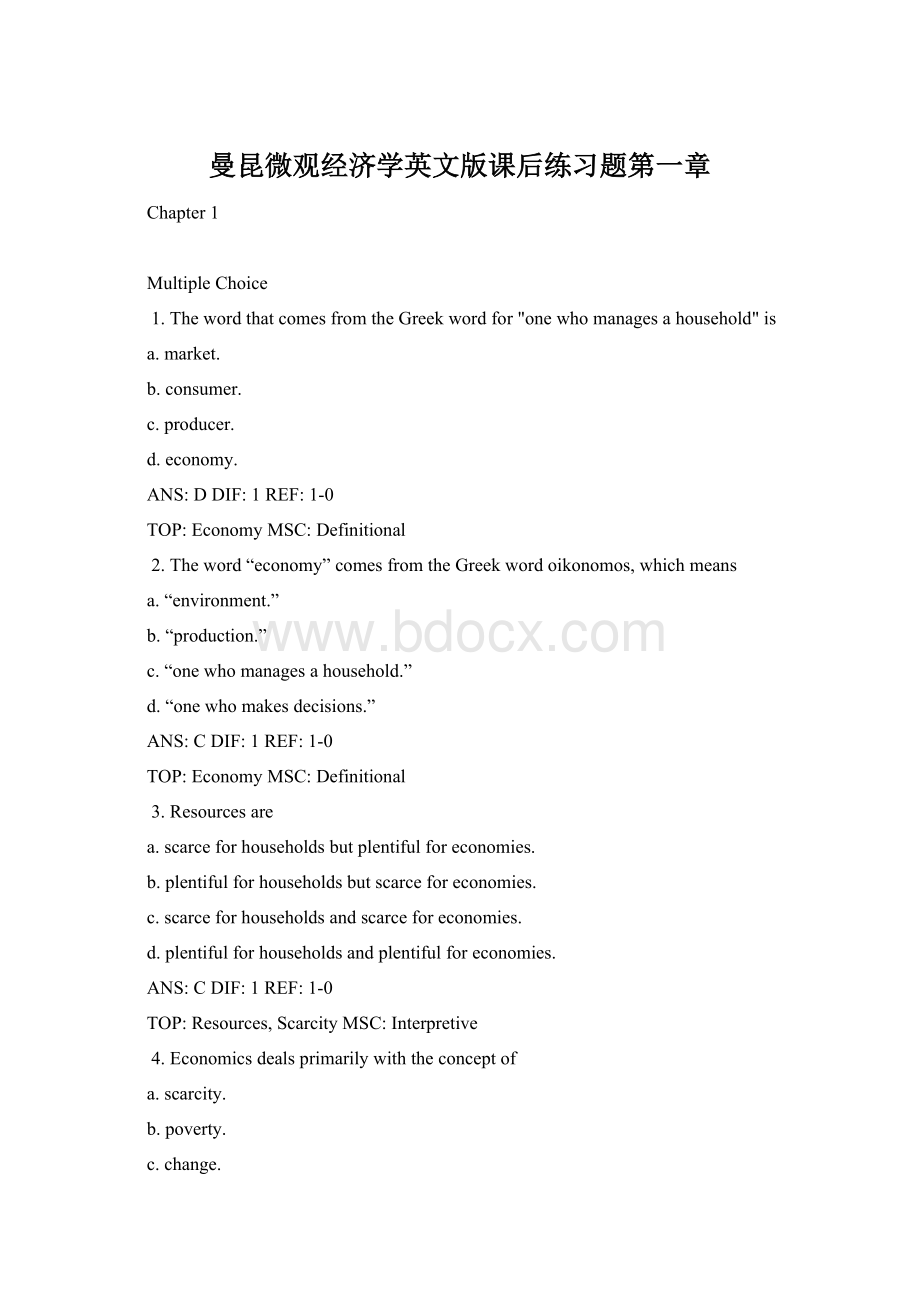曼昆微观经济学英文版课后练习题第一章.docx
《曼昆微观经济学英文版课后练习题第一章.docx》由会员分享,可在线阅读,更多相关《曼昆微观经济学英文版课后练习题第一章.docx(57页珍藏版)》请在冰豆网上搜索。

曼昆微观经济学英文版课后练习题第一章
Chapter1
MultipleChoice
1.ThewordthatcomesfromtheGreekwordfor"onewhomanagesahousehold"is
a.market.
b.consumer.
c.producer.
d.economy.
ANS:
DDIF:
1REF:
1-0
TOP:
EconomyMSC:
Definitional
2.Theword“economy”comesfromtheGreekwordoikonomos,whichmeans
a.“environment.”
b.“production.”
c.“onewhomanagesahousehold.”
d.“onewhomakesdecisions.”
ANS:
CDIF:
1REF:
1-0
TOP:
EconomyMSC:
Definitional
3.Resourcesare
a.scarceforhouseholdsbutplentifulforeconomies.
b.plentifulforhouseholdsbutscarceforeconomies.
c.scarceforhouseholdsandscarceforeconomies.
d.plentifulforhouseholdsandplentifulforeconomies.
ANS:
CDIF:
1REF:
1-0
TOP:
Resources,ScarcityMSC:
Interpretive
4.Economicsdealsprimarilywiththeconceptof
a.scarcity.
b.poverty.
c.change.
d.power.
ANS:
ADIF:
1REF:
1-0
TOP:
ScarcityMSC:
Definitional
5.Whichofthefollowingquestionsisnotansweredbythedecisionsthateverysocietymustmake?
a.Whatdeterminesconsumerpreferences?
b.Whatgoodswillbeproduced?
c.Whowillproducethegoods?
d.Whowillconsumethegoods?
ANS:
ADIF:
2REF:
1-0
TOP:
EconomiesMSC:
Interpretive
6.Theoverridingreasonastowhyhouseholdsandsocietiesfacemanydecisionsisthat
a.resourcesarescarce.
b.goodsandservicesarenotscarce.
c.incomesfluctuatewithbusinesscycles.
d.people,bynature,tendtodisagree.
ANS:
ADIF:
2REF:
1-0
TOP:
ScarcityMSC:
Interpretive
7.Thephenomenonofscarcitystemsfromthefactthat
a.mosteconomies’productionmethodsarenotverygood.
b.inmosteconomies,wealthypeopleconsumedisproportionatequantitiesofgoodsandservices.
c.governmentsrestrictsproductionoftoomanygoodsandservices.
d.resourcesarelimited.
ANS:
DDIF:
2REF:
1-0
TOP:
ScarcityMSC:
Interpretive
8.Approximatelywhatpercentageoftheworld'seconomiesexperiencescarcity?
a.25%
b.50%
c.75%
d.100%
ANS:
DDIF:
1REF:
1-0
TOP:
ScarcityMSC:
Interpretive
9.Whenasocietycannotproduceallthegoodsandservicespeoplewishtohave,itissaidthattheeconomyisexperiencing
a.scarcity.
b.shortages.
c.inefficiencies.
d.inequities.
ANS:
ADIF:
2REF:
1-0
TOP:
ScarcityMSC:
Interpretive
10.Forsociety,agoodisnotscarceif
a.atleastoneindividualinsocietycanobtainallheorshewantsofthegood.
b.firmsareproducingthegoodatfullcapacity.
c.allmembersofsocietycanhavealltheywantofthegood.
d.thosewhohaveenoughincomecanbuyalltheywantofthegood.
ANS:
CDIF:
1REF:
1-0
TOP:
ScarcityMSC:
Interpretive
11.Whichofthefollowingproductswouldbeconsideredscarce?
a.golfclubs
b.Picassopaintings
c.apples
d.Alloftheabovearecorrect.
ANS:
DDIF:
2REF:
1-0
TOP:
ScarcityMSC:
Interpretive
12.Economicsisthestudyof
a.productionmethods.
b.howsocietymanagesitsscarceresources.
c.howhouseholdsdecidewhoperformswhichtasks.
d.theinteractionofbusinessandgovernment.
ANS:
BDIF:
1REF:
1-0
TOP:
Economies,ScarcityMSC:
Definitional
13.Economicsisthestudyof
a.howsocietymanagesitsscarceresources.
b.thegovernment'sroleinsociety.
c.howamarketsystemfunctions.
d.howtoincreaseproduction.
ANS:
ADIF:
1REF:
1-0
TOP:
Economies,ScarcityMSC:
Definitional
14.Inmostsocieties,resourcesareallocatedby
a.asinglecentralplanner.
b.asmallnumberofcentralplanners.
c.thosefirmsthatuseresourcestoprovidegoodsandservices.
d.thecombinedactionsofmillionsofhouseholdsandfirms.
ANS:
DDIF:
1REF:
1-0
TOP:
ResourceallocationMSC:
Interpretive
15.Theadage,"Thereisnosuchthingasafreelunch,"isusedtoillustratetheprinciplethat
a.goodsarescarce.
b.peoplefacetradeoffs.
c.incomemustbeearned.
d.householdsfacemanydecisions.
ANS:
BDIF:
2REF:
1-1
TOP:
TradeoffsMSC:
Interpretive
16.Theadage,"Thereisnosuchthingasafreelunch,"means
a.evenpeopleonwelfarehavetopayforfood.
b.thecostoflivingisalwaysincreasing.
c.togetsomethingwelike,weusuallyhavetogiveupanotherthingwelike.
d.allcostsareincludedinthepriceofaproduct.
ANS:
CDIF:
1REF:
1-1
TOP:
TradeoffsMSC:
Definitional
17.Economistsusethephrase"Thereisnosuchthingasafreelunch,"toillustratetheprinciplethat
a.inflationalmostalwaysresultsinhigherpricesovertime.
b.nothingisfreeinamarketeconomy.
c.makingdecisionsrequirestradingoffonegoalagainstanother.
d.ifsomethinglookstoogoodtobetrue,itprobablyisnotworthpursuing.
ANS:
CDIF:
2REF:
1-1
TOP:
TradeoffsMSC:
Interpretive
18.Whichofthefollowingstatementsbestrepresentstheprinciplerepresentedbytheadage,"Thereisnosuchthingasafreelunch"?
a.Melissacanattendtheconcertonlyifshetakeshersisterwithher.
b.Gregishungryandhomeless.
c.Brianmustrepairthetireonhisbikebeforehecanrideittoclass.
d.KendramustdecidebetweengoingtoColoradoorCancunforspringbreak.
ANS:
DDIF:
3REF:
1-1
TOP:
TradeoffsMSC:
Applicative
19.Theprinciplethat"peoplefacetradeoffs"appliesto
a.individuals.
b.families.
c.societies.
d.Alloftheabovearecorrect.
ANS:
DDIF:
1REF:
1-1
TOP:
TradeoffsMSC:
Applicative
20.Atypicalsocietystrivestogetthemostitcanfromitsscarceresources.Atthesametime,thesocietyattemptstodistributethebenefitsofthoseresourcestothemembersofthesocietyinafairmanner.Inotherwords,thesocietyfacesatradeoffbetween
a.gunsandbutter.
b.efficiencyandequity.
c.inflationandunemployment.
d.workandleisure.
ANS:
BDIF:
1REF:
1-1
TOP:
Efficiency,EquityMSC:
Interpretive
21.Gunsandbutterareusedtorepresenttheclassicsocietaltradeoffbetweenspendingon
a.durableandnondurablegoods.
b.importsandexports.
c.nationaldefenseandconsumergoods.
d.lawenforcementandagriculture.
ANS:
CDIF:
1REF:
1-1
TOP:
TradeoffsMSC:
Interpretive
22.Whensocietyrequiresthatfirmsreducepollution,thereis
a.atradeoffbecauseofreducedincomestothefirms'ownersandworkers.
b.atradeoffonlyifsomefirmsareforcedtoclose.
c.notradeoff,sincethecostofreducingpollutionfallsonlyonthefirmsaffectedbytherequirements.
d.notradeoff,sinceeveryonebenefitsfromreducedpollution.
ANS:
ADIF:
3REF:
1-1
TOP:
TradeoffsMSC:
Applicative
23.Atradeoffexistsbetweenacleanenvironmentandahigherlevelofincomeinthat
a.studiesshowthatindividualswithhigherlevelsofincomeactuallypollutelessthanlow-incomeindividuals.
b.effortstoreducepollutiontypicallyarenotcompletelysuccessful.
c.lawsthatreducepollutionraisecostsofproductionandreduceincomes.
d.byemployingindividualstocleanuppollution,employmentandincomebothrise.
ANS:
CDIF:
2REF:
1-1
TOP:
TradeoffsMSC:
Applicative
24.Whichofthefollowingphrasesbestcapturesthenotionofefficiency?
a.absolutefairness
b.equaldistribution
c.minimumwaste
d.equitableoutcome
ANS:
CDIF:
1REF:
1-1
TOP:
EfficiencyMSC:
Interpretive
25.Whichofthefollowingistrue?
a.Efficiencyreferstothesizeoftheeconomicpie;equityreferstohowthepieisdivided.
b.Governmentpoliciesusuallyimproveuponbothequityandefficiency.
c.Aslongastheeconomicpiecontinuallygetslarger,noonewillhavetogohungry.
d.Efficiencyandequitycanbothbeachievediftheeconomicpieiscutintoequalpieces.
ANS:
ADIF:
2REF:
1-1
TOP:
Efficiency,EquityMSC:
Interpretive
26.Efficiencymeansthat
a.societyisconservingresourcesinordertosavethemforthefuture.
b.society'sgoodsandservicesaredistributedequallyamongsociety'smembers.
c.society'sgoodsandservicesaredistributedfairly,thoughnotnecessarilyequally,amongsociety'smembers.
d.societyisgettingthemaximumbenefitsfromitsscarceresources.
ANS:
DDIF:
1REF:
1-1
TOP:
EfficiencyMSC:
Definitional
27.Economistsusethewordequitytodescribeasituationinwhich
a.eachmemberofsocietyhasthesameincome.
b.eachmemberofsocietyhasaccesstoabundantquantitiesofgoodsandservices,regardlessofhisorherincome.
c.societyisgettingthemaximumbenefitsfromitsscarceresources.
d.thebenefitsofsociety'sresourcesaredistributedfairlyamongsociety'smembers.
ANS:
DDIF:
2REF:
1-1
TOP:
EquityMSC:
Interpretive
28.SenatorSmithwantstoincreasetaxesonpeoplewithhighincomesandusethemoneytohelpthepoor.SenatorJonesarguesthatsuchataxwilldiscouragesuccessfulpeoplefromworkingandwillthereforemakesocietyworseoff.Aneconomistwouldsaythat
a.weshouldagreewithSenatorSmith.
b.weshouldagreewithSenatorJones.
c.agooddecisionrequiresthatwerecognizebothviewpoints.
d.therearenotradeoffsbetweenequityandefficiency.
ANS:
CDIF:
2REF:
1-1
TOP:
Efficiency,EquityMSC:
Applicative
29.Whichofthefollowingwordsandphrasesbestcapturesthenotionofequity?
a.minimumwaste
b.maximumbenefit
c.sameness
d.fairness
ANS:
DDIF:
1REF:
1-1
TOP:
EquityMSC:
Definitional
30.Whengovernmentpoliciesareenacted,
a.equitycanusuallybeenhancedwithoutanefficiencyloss,butefficiencycanneverbeenhancedwithoutanequityloss.
b.efficiencycanusuallybeenhancedwithoutanequityloss,butequitycanneverbeenhancedwithoutanefficiencyloss.
c.itisalwaysthecasethateitherefficiencyandfairnessarebothenhanced,orefficiencyandequityarebothdiminished.
d.Noneoftheabovearecorrect.
ANS:
DDIF:
2REF:
1-1
TOP:
Government,Efficiency,EquityMSC:
Applicative
31.Alikelyeffectofgovernmentpoliciesthatredistributeincomeandwealthfromthewealthytothepooristh